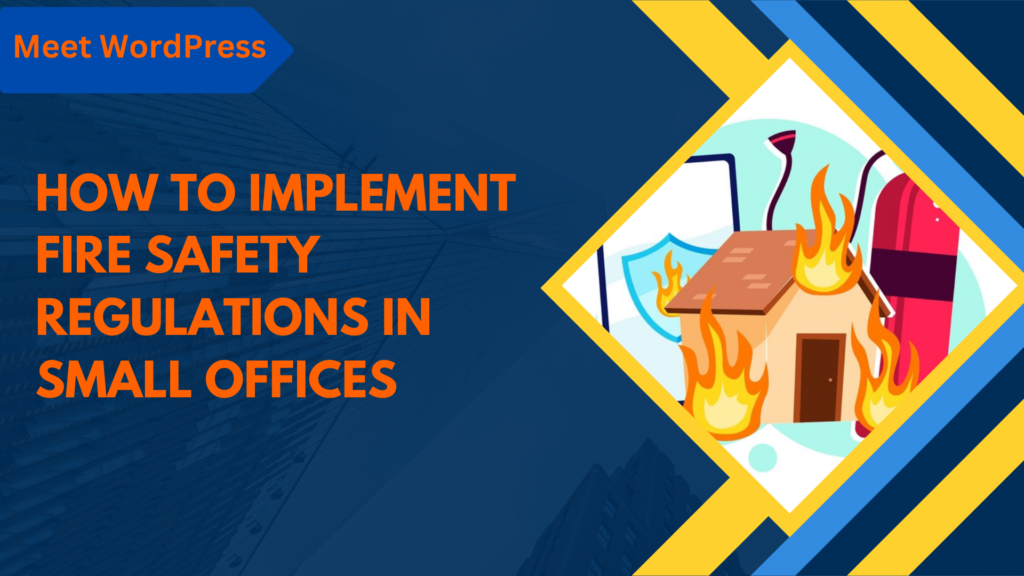Introduction
Fire safety is a very important concern in any workplace, including small offices. As a result of lack of resources and inadequate safety protocols, fire is particularly devastating for small businesses. Implementing necessary fire safety measures can not only save your employees’ and clients’ lives, it can also save your office from potential damages and help you avoid loss of assets. In this article, we will walk you through the fire safety regulations that you need to impose in your small office to uphold the law and maintain a safe work environment.
Understand Fire Safety Regulations and Standards
Research Local Fire Safety Codes
Essential Fire Safety Regulations to Be Followed Before Implementing Fire Safety Measures Fire codes differ from place to place and may include certain safety features, like fire exits, fire alarms, or sprinklers. To know this, you need to ask your local fire department or regulatory body to understand what is or isn’t legally required for small offices where you live.
National Fire Protection Association (NFPA) Guidelines
Beyond your local codes and requirements, consult the guidelines of the National Fire Prevention Association (NFPA) and other organizations. These standards cover everything from fire extinguisher placement to smoke detection systems and evacuation protocols, making the NFPA a one-stop shop for fire safety.
Perform a Fire Risk Assessment.
Identify Potential Fire Hazards
The first step towards fire safety is locating the fire hazards in your office. B. Perform a full inspection of the office space and identify common fire hazards, for example:
- So many power cords plugged into electrical outlets and power strips
- Negligent or aging electrical wiring
- Heating certain combustible materials and sources
- Obstructed escape routes and fire exit
- Preparation appliances in kitchens or break rooms
Evaluate the Risks
Identify potential fire hazards near your data centre and evaluate both the severity of potential fire damage and the likelihood a fire could be ignited by each hazard. For example, the power strip that has been loaded with too many devices may be a potential culprit of an electrical fire or combustibles in close proximity to a heat unit. Knowing which hazards are most likely to cause fire helps focus the fire safety efforts.
Create a Risk Mitigation Plan
Implement a mitigation plan for each identified risk. These actions include changing out old electrical equipment to prevent overloading circuits, keeping fire exits clear at all times and making sure that flammable materials are properly stored. Your fire risk management plan should include regular inspections and ongoing maintenance.

Install Fire Safety Equipment
Fire Extinguishers
Make sure your home office has the right type of fire extinguishers. Fire extinguishers must be accessible and should be installed in fire-hazard zones like kitchens, electrical rooms, etc. Be sure to train how to use extinguishers properly.
- Types of Fire Extinguishers:
- ABC extinguishers for general usage (paper, wood, electrical, and liquid fires).
- CO2 extinguishers for electrical fires.
Smoke Detectors and Fire Alarm Systems
Smoke detectors are a required item in every office. They sense smoke in the air and notify employees to evacuate before things get worse. Have smoke alarms installed in each room, notably those where electrical appliances are used, and check them regularly.
A connected fire alarm system linking alarms to one central panel will raise its alarm to a louder and more visible alarm if an employee is needed to alert them of a fire. On an annual basis, ensure that the fire alarm system remains intact and is inspected regularly.
Fire Sprinklers
A fire sprinkler system may be required for your office, depending on the type and layout of your office. Fire sprinklers can quickly contain or even douse a fire before it spreads. Talk to a fire safety professional to determine if your office space requires sprinklers.
Fire Blankets
In kitchens and break rooms, a fire blanket may come in handy in controlling minor fires. These blankets can be used to snuff out small flames—greatly reduce damage—and are made from heat-resistant materials.
4. Develop and Communicate Fire Safety Procedures
Create an Evacuation Plan
It may sound very basic, but a well-thought-out evacuation plan is essential to make sure the employees in the office can get out as soon as possible if a fire occurs. The plan should include:
- Clear evacuation routes.
- Use designated meeting points away from the building.
- Policies for persons with disabilities or other special needs.
- Location of fire exits, fire extinguishers, and alarm (maps).
Establish Roles and Responsibilities
Designate roles for employees in the event of a fire emergency. For example:
- Fire Warden: This person will help ensure that the building is evacuated properly and assist those who may need help.
- First Aid Team: If trained, this group should assist anyone injured in the course of the evacuation.
Regularly Update Fire Procedures
Regularly review and update the fire safety plan as needed to ensure it remains current with any changes to the office layout, personnel, or fire safety regulations. Communicate with employees about changes and make sure they are informed of their roles in the event of an emergency.
Fire Drills and Training
Schedule fire drills frequently to familiarize employees with the evacuation system. At minimum, there should be 1 fire drills every six months to remain fresh and prepared. Make sure you pay attention during these drills to identify issues (i.e., employees not taking the evacuation route) and correct them immediately.

Also, train all employees in fire safety. This training should cover:
- How to use a fire extinguisher.
- How to react if there’s a fire.
- Evacuation procedures.
- Importance of fire safety equipment
5. Maintain Fire Safety Equipment and Systems
Regular Inspections and Maintenance
Simply installing fire safety equipment is not enough and assuming it will be ready to go in an emergency. Regular inspections and maintenance are very important. For example:
- Fire Extinguishers: Check monthly that they’re fully charged and working properly. Get it serviced annually by a certified technician.
- Smoke Detectors and Alarms: Test detectors monthly, changing the batteries at least once a year. Arrange for yearly inspections to make sure they are working properly.
- Fire Sprinklers: Inspect and service by a professional fire sprinkler system once a year.
- Electrical Equipment: Periodically examine electrical wiring, outlets, and appliances to ensure safety compliance and replace any outdated or malfunctioning equipment.
Keep Fire Exits Unblocked
Fire exits should always be clear of obstacles. Eliminate any stacks of furniture, office supplies, and other materials that may block exit routes. Check regularly to ensure exits are accessible in an emergency situation.
6. Train Employees on Fire Safety
Employee Awareness
Keep employees and others informed about fire safety rules and regulations. Provide training on:
- Where fire extinguishers, alarms, and exits are located.
- Correct usage of fire safety equipment.
- What to do if there is a fire or emergency.
Safety Protocols in Specific Areas
If your office contains higher-risk fire areas (kitchens, server rooms, etc.), ensure that employees working in those areas have additional training. They must know how to deal with fire hazards related to their activities.
Encourage Reporting of Hazards
Encourage employees to report fire hazards or unsafe conditions in the workplace. Remind them to flag any potential hazards for immediate action, such as malfunctioning electrical equipment, blocked fire exits, or fire hazards in high-risk areas.
Conclusion
Fire safety regulations of an office in a small business are a serious business that every owner must abide by. A safer workplace for everyone can be achieved by familiarizing yourself with the relevant fire safety codes, conducting a thorough risk assessment, installing the equipment needed, and finally training your employees. Be sure, fire safety is an ongoing process, and it requires continuous maintenance, training, and diligence. Enacting fire safety measures in advance can help avoid unnecessary disasters and will make sure your office is prepared in case of an emergency.
FAQs
1. Are fire safety regulations different for small offices compared to larger businesses?
Yes, small offices might be exempt from some requirements, but they still must comply with many of the same regulations. Be sure to review local fire codes and adhere to appropriate directives that apply to your specific office size and layout.
2. How often should fire safety equipment be inspected?
Fire extinguishers need to be inspected once a month, and smoke detectors and alarms need to be tested at least once a month. Fire sprinkler systems: Have them inspected by professionals annually.
3. Do I need professional help to install fire safety equipment?
Entities of all sizes from all over the world—as well as training on everything from fire sprinklers to fire alarm systems—can potentially be classified as systems utility (for all kinds of systems utility). Make sure you are in accordance with fire safety regulations; you can also consult with a fire safety expert to have the proper setup.
4. How can I ensure employees follow fire safety procedures?
Fire drills should take place regularly so that employees familiarize themselves with the fire exit paths and the fire safety protocols they need to follow in a crisis. A culture of safety and accountability can enhance compliance as well.


